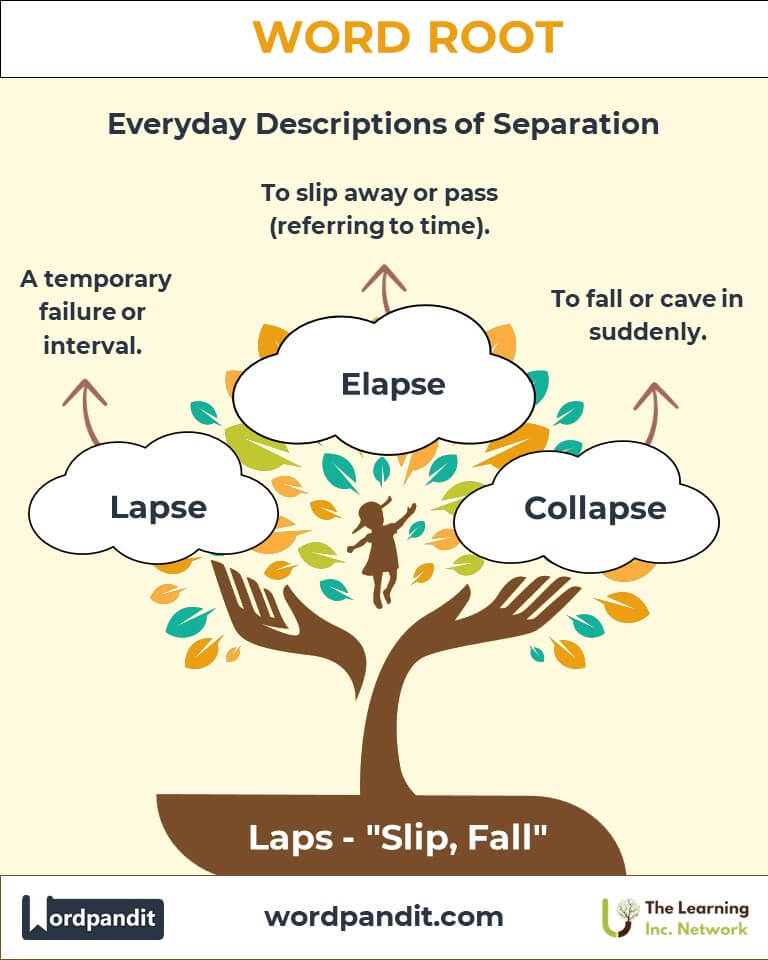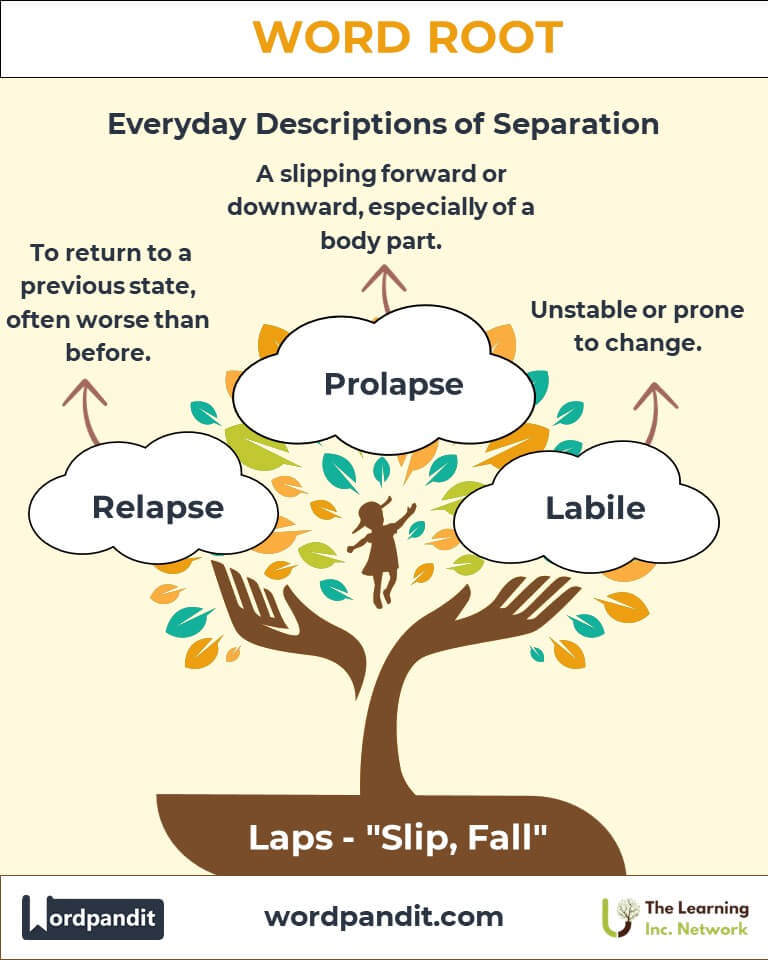Laps: The Art of Slipping and Falling in Language
Byline: Discover the fascinating journey of the root "laps," derived from Latin, meaning "slip" or "fall." From terms like "collapse" to "relapse," this root elegantly encapsulates moments of decline, recovery, and unexpected motion across disciplines and daily life.

Table of Contents
- Introduction: The Role of Laps- in Language
- Etymology and Historical Journey
- Mnemonic: Unlocking the Power of Laps
- Common Laps-Related Terms
- Laps Through Time
- Laps in Specialized Fields
- Illustrative Story: Laps in Action
- Cultural Significance of the Laps Root
- The Laps Family Tree
- FAQs About the "Laps" Word Root
- Test Your Knowledge: "Laps" Mastery Quiz
- Conclusion: The Enduring Legacy of Laps
1. Introduction: The Essence of "Laps"
Have you ever witnessed a collapse of a sandcastle as waves sweep it away or experienced a relapse in efforts after a temporary success? The root "laps," pronounced as "laps," paints vivid pictures of slipping or falling—whether literal or metaphorical. Originating from Latin, this versatile root finds its way into terms describing physical movements, emotional setbacks, and even periods of time slipping away.

2. Etymology and Historical Journey
The root "laps" stems from the Latin word labi, meaning "to slip" or "to glide." Over centuries, it evolved into terms depicting both graceful motions and sudden falls. By the Middle Ages, "laps" had enriched English, conveying a wide range of meanings, from physical collapses to moral relapses.
Notably, "laps" terms often appeared in literature and religious texts, symbolizing human frailty and redemption. The poetic imagery of slipping, falling, and recovering resonated across cultures and time.
3. Mnemonic: Unlocking the Power of "Laps"
Imagine a person walking on a slippery surface, suddenly losing their footing, and gracefully recovering. This vivid scene captures the essence of "laps," helping you connect the root to its meaning.
Mnemonic Device: “Think of a lapse as a slip, a relapse as a second slip, and collapse as a dramatic fall.”
4. Common "Laps"-Related Terms
- Collapse (kuh-laps):
- Definition: To fall or cave in suddenly.
- Example: "The old bridge collapsed under the weight of the heavy truck."
- Relapse (ree-laps):
- Definition: To return to a previous state, often worse than before.
- Example: "After months of sobriety, he experienced a relapse."
- Elapse (ee-laps):
- Definition: To slip away or pass (referring to time).
- Example: "Several hours elapsed before the rescue team arrived."
- Lapse (laps):
- Definition: A temporary failure or interval.
- Example: "A lapse in concentration caused the athlete to miss the goal."
- Prolapse (pro-laps):
- Definition: A slipping forward or downward, especially of a body part.
- Example: "The patient underwent surgery for a rectal prolapse."
5. "Laps" Through Time
- Lapse (Medieval): Initially used to describe moral or spiritual failures, this term often appeared in religious writings.
- Collapse (Modern): With industrialization, the word gained prominence in describing physical structures falling apart, reflecting societal concerns about safety and durability.
- Relapse (Contemporary): Widely associated with health and addiction recovery, "relapse" highlights the cyclical challenges of human perseverance.
6. "Laps" in Specialized Fields
- Medicine:
- Prolapse: Describes organ displacement, significant in gynecology and surgery.
- Relapse: Commonly used in discussions about diseases or addiction recovery.
- Engineering:
- Collapse: Essential for analyzing structural failures and disaster prevention.
- Chronology:
- Elapse: Tracks time intervals, crucial in fields like history and physics.
7. Illustrative Story: "Laps" in Action
Maya, a determined marathon runner, experienced a momentary lapse in her focus, leading her to stumble. Undeterred, she recovered and completed the race. Her collapse was a reminder of her humanity, while her triumph over it symbolized resilience. Reflecting later, Maya said, “Even in a lapse, there’s a chance to rise.”
8. Cultural Significance of the "Laps" Root
The root "laps" often symbolizes fragility and resilience in literature and art. It resonates in themes of moral struggles and redemption, as seen in classic works like Dante’s Inferno. The imagery of slipping and recovering continues to inspire metaphors for human experiences.

9. The "Laps" Family Tree
- Lab (Latin: "slip"):
- Labile: Unstable or prone to change.
- Cad (Latin: "fall"):
- Cadence: The rhythmic fall of sounds.
- Clud (Latin: "close"):
- Seclude: To close off or isolate.

FAQs About the "Laps" Word Root
Q: What does the root "laps" mean?
A: The root "laps" comes from the Latin labi, meaning "to slip" or "to fall." It describes both physical actions (like a collapse) and metaphorical ones (such as a lapse in judgment).
Q: How does "lapse" differ from "relapse"?
A: A lapse refers to a brief or temporary failure, such as forgetting to do something. A relapse indicates a return to a previous, often worse, condition, such as falling back into illness.
Q: What is the difference between "collapse" and "prolapse"?
A: Collapse refers to a sudden and complete fall, such as a building falling down. Prolapse specifically relates to medical conditions where an organ slips from its normal position.
Q: How is "elapse" used in time-related contexts?
A: Elapse refers to the passage of time, such as "Ten years elapsed before they met again," meaning ten years passed unnoticed.
Q: Why is "relapse" commonly used in medicine and addiction contexts?
A: "Relapse" describes returning to a previous state, such as a disease reoccurring after improvement or falling back into addiction after recovery.
Test Your Knowledge: "Laps" Mastery Quiz
1. What does the root "laps" signify?
2. Which word describes a sudden cave-in?
3. What does "elapse" measure?
4. What term describes organ displacement?
5. What is a relapse?
Conclusion: The Living Legacy of "Laps"
The root "laps" eloquently captures the essence of human imperfection and recovery. From collapsing bridges to relapsing habits, its presence in our language reflects the realities of life’s ups and downs. As we continue to evolve, the root reminds us that every fall carries the potential for a rise, keeping "laps" relevant and powerful in our linguistic tapestry.












